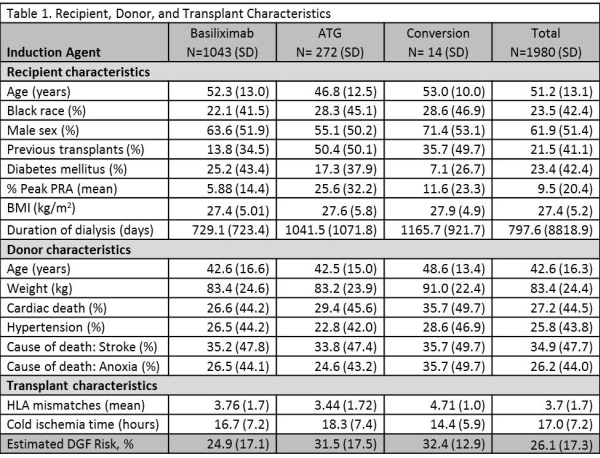The Association of Basiliximab and Antithymocyte Globulin Induction With Delayed Graft Function
1Department of Pharmacy, University of Wisconsin Hospital and Clinics, Madison, WI
2Department of Medicine - Division of Nephrology, University of Wisconsin Hospital and Clinics, Madison, WI.
Meeting: 2015 American Transplant Congress
Abstract number: B300
Keywords: Graft function, Induction therapy, Kidney transplantation, Risk factors
Session Information
Session Name: Poster Session B: Late Breaking
Session Type: Poster Session
Date: Sunday, May 3, 2015
Session Time: 5:30pm-6:30pm
 Presentation Time: 5:30pm-6:30pm
Presentation Time: 5:30pm-6:30pm
Location: Exhibit Hall E
The impact of selection of induction immunosuppression agent on incidence of delayed graft function (DGF) remains unclear. A total of 1,980 deceased donor kidney transplant recipients between 2000-2012 were divided into subgroups based on induction agent (Table 1). DGF was defined as use of dialysis within 7 days following transplantation. Basiliximab was utilized in 52.7% of the kidney transplants, while rabbit antithymocyte globulin (ATG, Thymoglobulin) was utilized in 13.7%. Fourteen patients were converted from basiliximab to ATG. The pre-transplant DGF risk (Irish et al, AJT 2010) was higher for patients receiving ATG than those receiving basiliximab (p<0.001) and similar to those converted from basiliximab to ATG (p=0.87). However, basiliximab was associated with a lower risk of DGF in propensity score-stratified models adjusted for pre-transplant DGF risk score (Table 2). Furthermore, conversion from basiliximab to ATG was not associated with a lower incidence of DGF.
These studies suggest that IL-2R inhibition may be associated with a lower incidence of DGF than ATG induction. However, randomized controlled trials are needed to specifically address the ideal induction therapy for the prevention of DGF.


To cite this abstract in AMA style:
Felix D, Astor B, Hager D, Djamali A. The Association of Basiliximab and Antithymocyte Globulin Induction With Delayed Graft Function [abstract]. Am J Transplant. 2015; 15 (suppl 3). https://atcmeetingabstracts.com/abstract/the-association-of-basiliximab-and-antithymocyte-globulin-induction-with-delayed-graft-function/. Accessed December 17, 2025.« Back to 2015 American Transplant Congress
